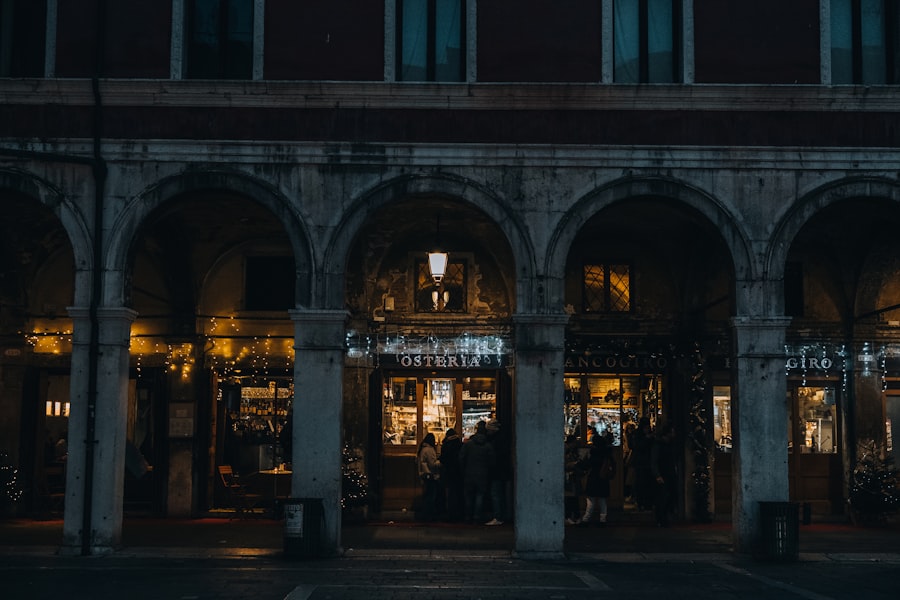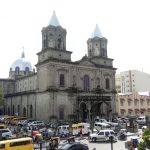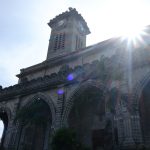Download links
How to install Manila Cathedral: A Historic Gem in the Philippines APK?
1. Tap the downloaded Manila Cathedral: A Historic Gem in the Philippines APK file.
2. Touch install.
3. Follow the steps on the screen.
Description
The Manila Cathedral, officially known as the Cathedral-Basilica of the Immaculate Conception, stands as a monumental symbol of faith and resilience in the heart of the Philippines’ capital city. This iconic structure is not merely a place of worship; it embodies the rich tapestry of Philippine history, culture, and spirituality. Nestled within the historic Intramuros district, the cathedral serves as the mother church of the Archdiocese of Manila, making it a pivotal center for Catholicism in the country.
Its towering façade and intricate details draw both locals and tourists alike, inviting them to explore its sacred spaces and appreciate its historical significance. As one approaches the cathedral, the grandeur of its architecture becomes immediately apparent. The imposing façade, adorned with statues and intricate carvings, reflects a blend of Romanesque and Gothic styles that have evolved over centuries.
The cathedral’s role extends beyond that of a religious institution; it is a cultural landmark that has witnessed the ebb and flow of Philippine history, from colonial times to modern-day challenges. The Manila Cathedral is not just a building; it is a living testament to the enduring spirit of the Filipino people and their unwavering faith.
Key Takeaways
- Manila Cathedral is a historic and iconic landmark in the Philippines, located in the heart of Intramuros, Manila.
- The cathedral has a rich history dating back to the Spanish colonial period and has undergone several reconstructions due to natural disasters and war.
- The architecture and design of Manila Cathedral showcase a blend of different styles, including Romanesque, Renaissance, and Baroque influences.
- The cathedral has been witness to significant events and has been visited by notable figures, including Pope John Paul II and various heads of state.
- Efforts to restore and preserve Manila Cathedral have been ongoing, with the latest restoration completed in 2014, ensuring its continued significance in Philippine culture and history.
History of Manila Cathedral
The history of Manila Cathedral is a narrative woven with threads of triumph and tragedy. The original structure was built in 1581, making it one of the oldest churches in the Philippines. However, this first iteration was not destined to last; it succumbed to various calamities, including fires and earthquakes that plagued the region.
Each time disaster struck, the cathedral was rebuilt, reflecting the resilience of the community that cherished it. The most significant reconstruction occurred after World War II when much of Intramuros was devastated by bombings. The cathedral was rebuilt in 1954 under the guidance of architect Fernando Ocampo, who sought to restore its former glory while incorporating modern elements.
Throughout its history, the cathedral has served as a witness to pivotal moments in Philippine history. It has hosted numerous significant events, including the consecration of archbishops and the celebration of national events. The cathedral’s walls have echoed with prayers during times of national crisis, such as during the People Power Revolution in 1986, when it became a sanctuary for those seeking solace and guidance.
Each chapter in its history adds depth to its identity, making it not just a religious site but a repository of collective memory for Filipinos.
Architecture and Design of Manila Cathedral

The architectural design of Manila Cathedral is a harmonious blend of various styles that reflect its long history and the influences that have shaped it over time. The current structure showcases a Neo-Romanesque style characterized by its grand arches, robust columns, and intricate stone carvings. The façade is particularly striking, featuring a large rose window that bathes the interior in natural light, creating an ethereal atmosphere for worshippers.
The use of local materials in its construction not only enhances its aesthetic appeal but also roots it firmly in its geographical context. Inside, the cathedral boasts an impressive array of artistic elements that contribute to its spiritual ambiance. The high vaulted ceilings are adorned with beautiful frescoes and religious iconography that narrate biblical stories and saints’ lives.
The altar is a focal point, intricately designed and often embellished with flowers during special occasions. The use of stained glass windows further enhances the interior’s beauty, casting colorful patterns on the stone floors as sunlight filters through them. Each design choice reflects a deep reverence for tradition while embracing artistic innovation, making Manila Cathedral a masterpiece of ecclesiastical architecture.
Significant Events and People at Manila Cathedral
| Event/Person | Description | Date |
|---|---|---|
| Construction of Manila Cathedral | The original structure was built in 1571 and has undergone several renovations and rebuilds due to natural disasters and wars. | 1571 |
| Earthquake of 1863 | The cathedral was severely damaged by an earthquake and was later reconstructed in the 1870s. | 1863 |
| Archbishop Rufino Jiao Santos | He was the first Filipino archbishop of Manila and played a significant role in the history of the cathedral. | 1953-1983 |
| Pope John Paul II Visit | Pope John Paul II visited the cathedral in 1981, making it a significant event in its history. | 1981 |
| Restoration of Manila Cathedral | The cathedral underwent a major restoration project from 2012 to 2014 to preserve its historical and cultural significance. | 2012-2014 |
Manila Cathedral has been the backdrop for numerous significant events that have shaped both religious and national identity in the Philippines. One notable event was the funeral of President Manuel L. Quezon in 1944, which underscored the cathedral’s role as a national symbol during tumultuous times.
The cathedral has also been a site for various papal visits, including Pope John Paul II’s visit in 1995 during World Youth Day, which drew thousands of young people from around the world to celebrate their faith in this historic venue. In addition to these events, many prominent figures have been associated with Manila Cathedral throughout its history. Cardinal Jaime Sin, one of the most influential religious leaders in Philippine history, played a crucial role during the People Power Revolution.
His presence at the cathedral during this pivotal moment galvanized support for democratic change and highlighted the church’s influence in societal matters. The cathedral has also been a venue for interfaith dialogues and community gatherings, reinforcing its position as a center for unity and peace among diverse groups within Philippine society.
Restoration and Preservation Efforts of Manila Cathedral
The preservation of Manila Cathedral has been an ongoing endeavor that reflects both respect for heritage and an understanding of modern needs. After World War II, extensive restoration efforts were undertaken to rebuild the cathedral from the ground up. These efforts were not merely about reconstructing a building; they involved meticulous research into historical records to ensure that the new structure honored its predecessors while incorporating contemporary architectural techniques.
In recent years, further restoration projects have focused on maintaining the integrity of the cathedral’s design while enhancing its facilities for visitors and worshippers alike. This includes upgrading lighting systems to better showcase its artistic features and improving accessibility for individuals with disabilities. The Archdiocese of Manila has also engaged in educational initiatives aimed at raising awareness about the cathedral’s historical significance among younger generations.
Importance of Manila Cathedral in Philippine Culture and History

Manila Cathedral occupies a unique place in Philippine culture and history, serving as both a spiritual haven and a cultural landmark. Its significance extends beyond religious observance; it is intertwined with national identity and collective memory. For many Filipinos, attending mass at the cathedral is not just an act of faith but also a connection to their heritage and community.
The cathedral has become synonymous with major life events such as baptisms, weddings, and funerals, marking important milestones in individual lives while reinforcing communal bonds. Moreover, Manila Cathedral stands as a symbol of resilience amid adversity. Its ability to withstand natural disasters and historical upheavals mirrors the Filipino spirit—one characterized by hope, perseverance, and faith.
As such, it serves as a reminder of the importance of preserving cultural heritage in an ever-changing world. The cathedral’s role in fostering dialogue among different faiths and communities further emphasizes its importance as a unifying force within Philippine society. In this way, Manila Cathedral transcends its physical structure; it embodies the enduring values and aspirations of a nation striving for unity amidst diversity.
If you’re interested in exploring more about technology and innovation, you may want to check out the article on super fast charging with Charge Master 2020. This article discusses the latest advancements in charging technology and how it can benefit users. You can read more about it here.
FAQs
What is the Manila Cathedral?
The Manila Cathedral, also known as the Metropolitan Cathedral of the Immaculate Conception, is a Roman Catholic basilica located in the Intramuros district of Manila, Philippines.
When was the Manila Cathedral built?
The original Manila Cathedral was built in 1581, but it has been destroyed and rebuilt several times due to natural disasters and wars. The current structure was completed in 1958.
What is the architectural style of the Manila Cathedral?
The Manila Cathedral features a combination of architectural styles, including Baroque, Neo-Romanesque, and Neo-Byzantine influences.
What is the significance of the Manila Cathedral?
The Manila Cathedral is a significant religious and cultural landmark in the Philippines. It has been the site of many important events in the country’s history, including the papal visits of Pope Paul VI and Pope John Paul II.
Is the Manila Cathedral open to the public?
Yes, the Manila Cathedral is open to the public for worship, prayer, and guided tours. Visitors are welcome to explore the cathedral’s interior and learn about its history and significance.





